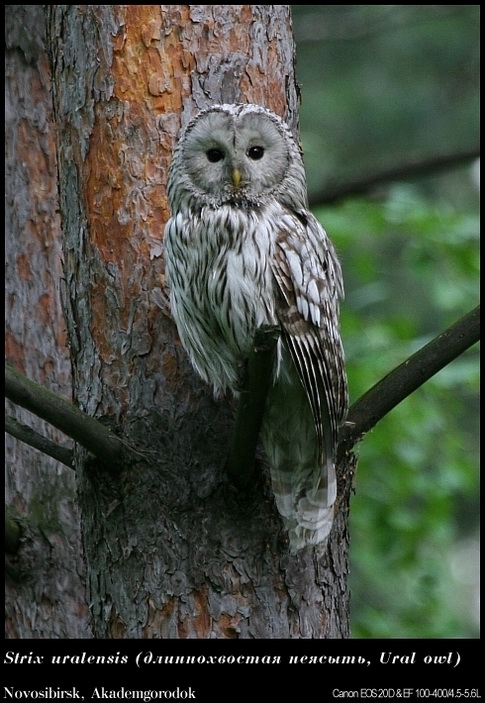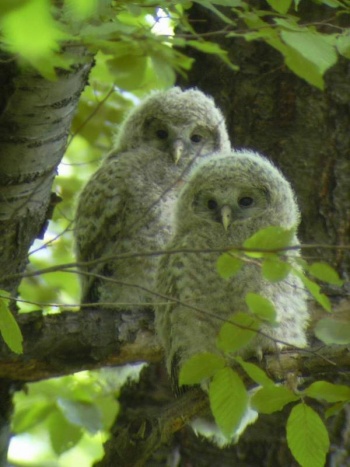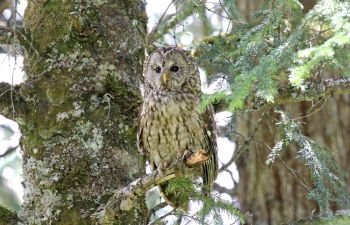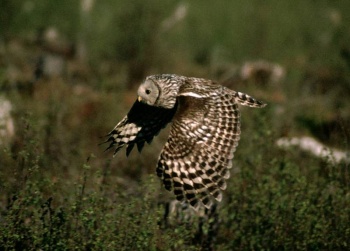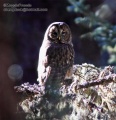Includes Pere David's Owl = Sichuan Wood-Owl
- Strix uralensis
Identification
Length: 50–62 cm (19¾-24½ in); wingspan: 95–134 cm (37½-52¾ in); weight: male 500–950 g, female 570–1300 g.
- Pale, buff grey-brown plumage
- Dark brown streaking on back, back of the head and underparts
- Round head
- Plain buff-grey facial disc
- Orange-yellow bill
- Small black eyes
- Long wedge-shaped tail
- Dark barring on the uppertail
- Rounded wings
Sexes are similar, with no seasonal variation
Distribution
From Japan and Korea in the east to Scandinavia and eastern central Europe in the west.
Taxonomy
Subspecies davidi was formerly considered a full species, Pere David's Owl, but research has reported that both plumage and vocalizations are largely overlapping.
Subspecies
This is a polytypic species; eight subspecies are recognized.[1].
- S. u. liturata:
- S. u. uralensis:
- Eastern European Russia to Sea of Okhotsk
- S. u. macroura:
- Carpathian Mountains to Bulgaria and western Balkans
- S. u. yenisseensis:
- Central Siberian plateau
- S. u. nikolskii:
- S. u. japonica:
- Hokkaido (northern Japan)
- S. u. hondoensis:
- Northern and central Honshu (Japan)
- S. u. fuscescens:
- Southern Honshu south to Kyushu (Japan)
- S. u. davidi
- Mountains of central China (southeast Qinghai and Sichuan)
Habitat
Forests with openings, ranging from mostly coniferous in the north to beach in south. Quite often in areas near birch or alder swamps. In central Europe only in mountains .
Behaviour
Breeding
They nest in hollow tree trunks. The 2-4 eggs are incubated for 27-34 days. The young leave the nest after about four weeks, but will not fly until about six weeks old. The attending parent has been known to attack humans approaching too closely.
Diet
Mostly active at dawn and dusk with some activity at night; in northern areas also active at day during time of feeding of young. The diet constitutes mainly rodents, supplemented with medium-sized birds such as Jays, Hazel Grouse, and Woodpigeon as needed.
Gallery
References
- Clements, J. F., T. S. Schulenberg, M. J. Iliff, T. A. Fredericks, J. A. Gerbracht, D. Lepage, S. M. Billerman, B. L. Sullivan, and C. L. Wood. 2022. The eBird/Clements checklist of Birds of the World: v2022. Downloaded from https://www.birds.cornell.edu/clementschecklist/download/
- Gill, F, D Donsker, and P Rasmussen (Eds). 2022. IOC World Bird List (v 12.2) DRAFT. Doi 10.14344/IOC.ML.12.2. http://www.worldbirdnames.org/
- König, C. and F. Weick 2008. Owls of the World, second edition. Christopher Helm, London. ISBN 978-0-7136-6548-2
- Wikipedia contributors. (2019, May 20). Ural owl. In Wikipedia, The Free Encyclopedia. Retrieved 08:28, May 21, 2019, from https://en.wikipedia.org/w/index.php?title=Ural_owl&oldid=897929901
- Brazil, M. (2018). Birds of Japan. Helm, London. ISBN 978-1-4729-1386-9
- Holt, D.W., Berkley, R., Deppe, C., Enríquez Rocha, P., Petersen, J.L., Rangel Salazar, J.L., Segars, K.P., Wood, K.L. & Marks, J.S. (2017). Ural Owl (Strix uralensis). In: del Hoyo, J., Elliott, A., Sargatal, J., Christie, D.A. & de Juana, E. (eds.). Handbook of the Birds of the World Alive. Lynx Edicions, Barcelona. (retrieved from http://www.hbw.com/node/55042 on 26 June 2017).
Recommended Citation
- BirdForum Opus contributors. (2025) Ural Owl. In: BirdForum, the forum for wild birds and birding. Retrieved 13 May 2025 from https://www.birdforum.net/opus/Ural_Owl
External Links
GSearch checked for 2020 platform.1




